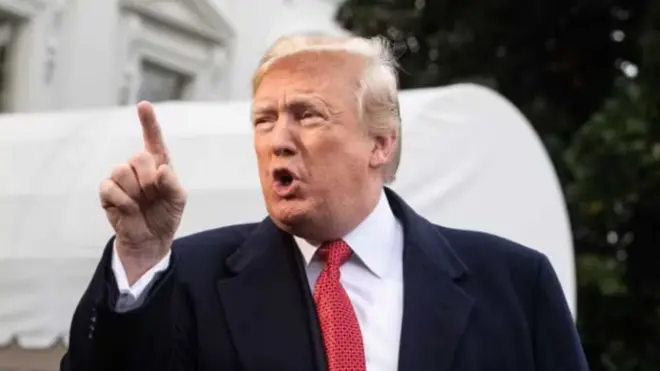Trump Directs His Govt To Prepare For Large-Scale Federal Layoffs Who Don’t Respond To Musk’s OPM Mail- wna24
[ad_1]

Trump Directs His Govt To Prepare For Large-Scale Federal Layoffs Who Don’t Respond To Musk’s OPM Mail | Image:
X
New Delhi: President Donald Trump during his first cabinet address on Wednesday issued a stern warning to federal employees, following billionaire Elon Musk’s recent email from the Office of Personnel Management (OPM) requesting that workers report five key accomplishments from the past week. During a press briefing, Trump indicated that employees who fail to respond to the email could face termination, adding that those who have not replied are “on the bubble.”
“We’re giving people every opportunity to send an email, but if they don’t respond, maybe they’re going to be gone,” Trump remarked.
Also Read: ‘Anybody Unhappy with Elon? We’ll Throw You Out’: Trump to Cabinet
His comments echoed a previous statement from Elon Musk, who said, “We’re going to send another email.”
The email, which asked employees to list five recent achievements, has sparked confusion, with some initially perceiving the response as mandatory. While the OPM later clarified that replies were voluntary, Trump’s comments emphasized the administration’s impatience with what he called “non-responsiveness” among federal workers.
Trump further questioned whether certain federal employees were even contributing to the agencies they serve. “I wouldn’t say that we’re thrilled about it. They haven’t responded,” he said. “Some of them, maybe they don’t exist.”
Also Read: President Trump’s Frist Cabinet Meeting Starts With a Prayer | WATCH
Everything About the New Memo That Says it All
A memo was also distributed by President Donald Trump ‘s administration that sets in motion what could become a sweeping realignment of American government.
The memo expands the Republican president’s effort to downsize the federal workforce, which he has described as an impediment to his agenda. Thousands of probationary employees have already been fired, and now his administration is turning its attention to career officials with civil service protection.
“We’re cutting down the size of the government. We have to,” Trump said during the first Cabinet meeting of his second term. “We’re bloated. We’re sloppy. We have a lot of people that aren’t doing their job.”
Agencies are directed to submit by March 13 their plans for what is known as a reduction in force, which would not only lay off employees but eliminate the position altogether. The result could be extensive changes in how the government functions.
More plans are due on April 14, when agencies are expected to outline how they will consolidate management, become more efficient and potentially relocate offices to parts of the country that are less expensive than Washington. The memo said agencies should implement their plans by Sept. 30.
Administration officials framed their effort as a cost-saving measure but with a clear ideological goal.
“The federal government is costly, inefficient, and deeply in debt. At the same time, it is not producing results for the American public,” said the memo from Russell Vought, director of the White House’s Office of Management and Budget , and Charles Ezell, acting director of the Office of Personnel Management, which functions as a human resources agency.
“Instead, tax dollars are being siphoned off to fund unproductive and unnecessary programs that benefit radical interest groups while hurting hard-working American citizens.”
Kevin Owen, an employment lawyer who represents federal workers, compared the administration’s initiative to the kind of disruptions that are caused by government shutdowns during congressional budget standoffs.
“This looks like a plan for a significant and shocking reduction of the federal workforce that I don’t think the American people are prepared for,” Owen said. “It’s going to cripple a lot of government functions.”
He said that Trump and his allies were focusing on speed rather than precision as they overhaul the government.
“Their plan is to do the damage and get sued,” he said. If a court ultimately rules against them, “by that point, they would have gotten what they wanted in interim.”
Specific targets for reductions were not included in the memo, but Trump said the Environmental Protection Agency could cut its workforce by 65%.
Trump foreshadowed the effort in an executive order that he signed with Elon Musk, the billionaire entrepreneur who oversees the so-called Department of Government Efficiency, known as DOGE.
The order said agency leaders “shall promptly undertake preparations to initiate large-scale reductions in force,” or RIF.
Some departments have already begin this process. The General Services Administration, which handles federal real estate, told employees on Monday that a reduction in force was underway and they would “everything in our power to make your departure fair and dignified.”
Law enforcement, national security, public safety, military positions and U.S. Postal Service positions are exempt.
The memo was released shortly before Trump convened Cabinet officials as well as Musk, who attended the meeting wearing a black “Make America Great Again” campaign hat.
Musk described himself during the meeting as “humble tech support” for the federal government, and he talked about his cost-cutting crusade in existential terms. “If we don’t do this, America will go bankrupt,” he said.
Musk has caused turmoil within the federal workforce, most recently by demanding that employees justify their jobs or risk getting fired. OPM later said that the edict was voluntary, although workers could face similar requests in the future.
He described his request as a “pulse check.” “Are these people real? Are they alive? And can they write an email?” he said. Before the meeting, White House press secretary Karoline Leavitt told reporters that “all of the Cabinet secretaries take the advice and direction of DOGE.”
“They’ll be providing updates on their efforts, and they’ll also be providing updates on what they’re doing at their agencies in terms of policies and implementing the promises that the president made on the campaign trail,” Leavitt said.
[ad_2]
Source link
